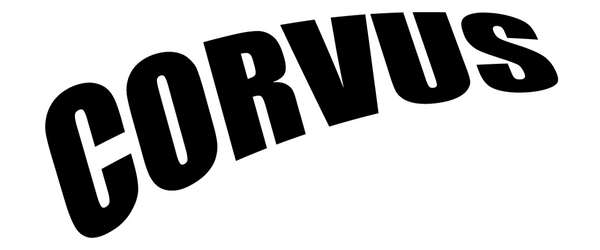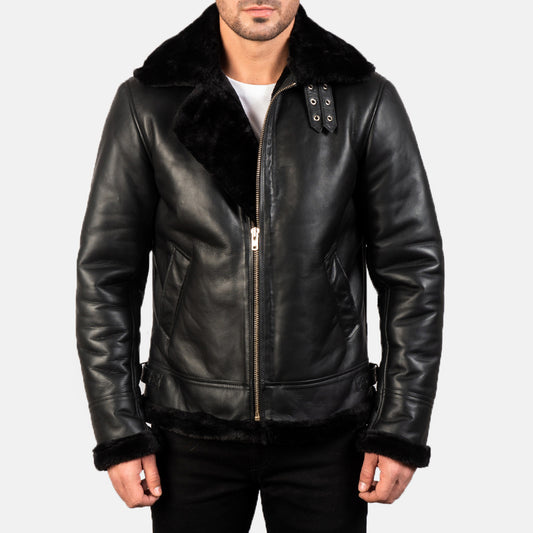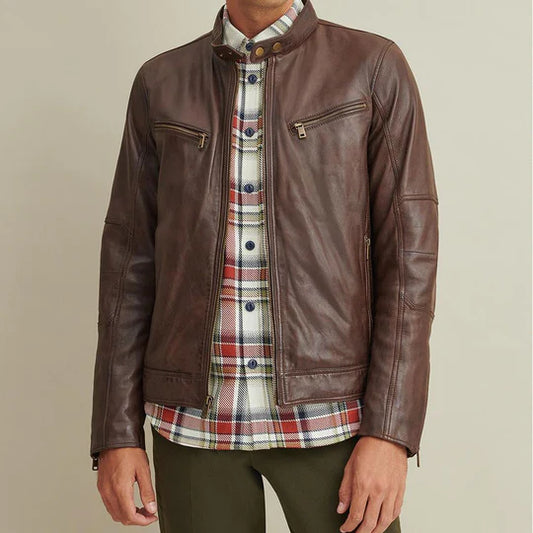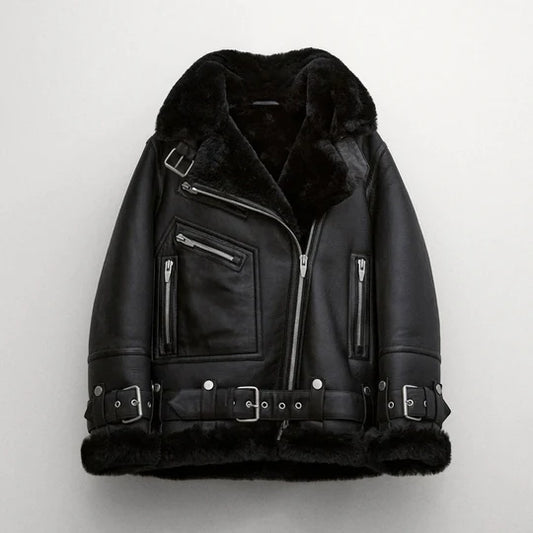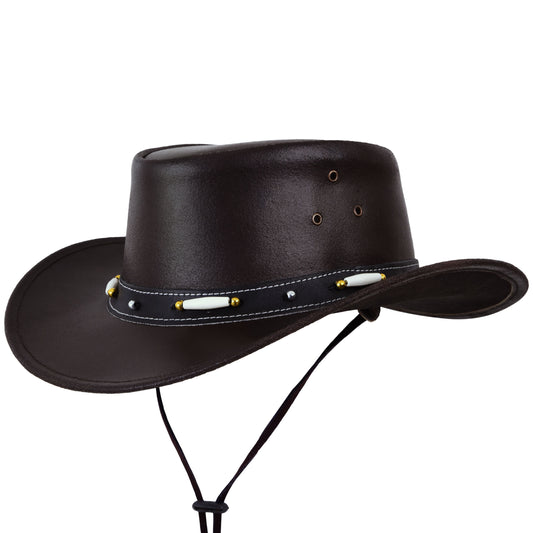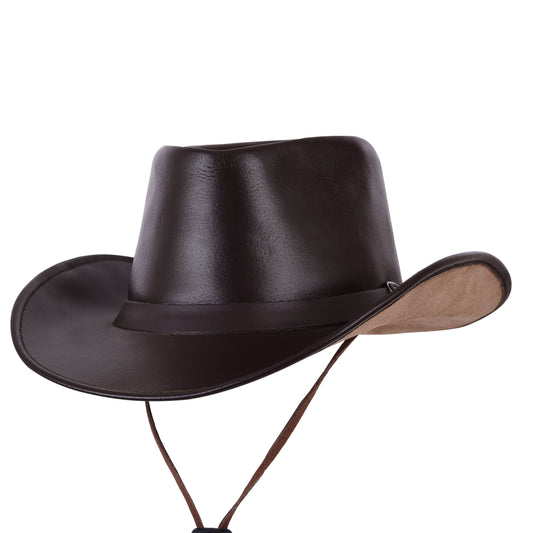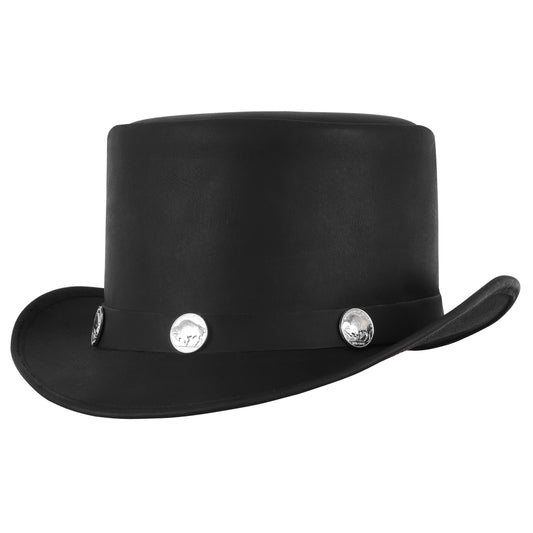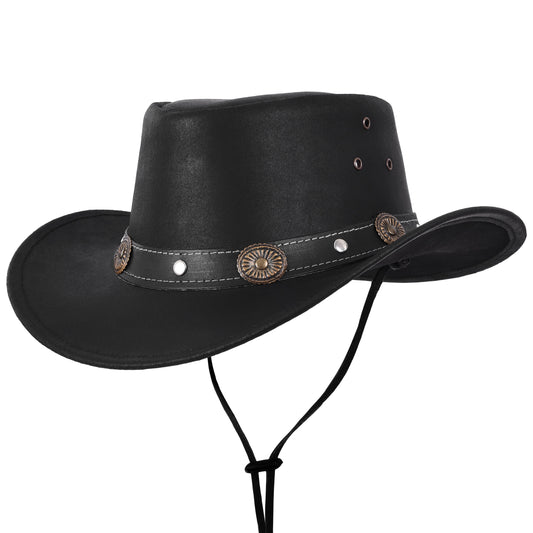Shearling leather jackets are particularly appealing in the fashion industry because they combine classic design with useful practicality. These sheepskin coats, which retain their wool, provide exceptional warmth and a stylish yet rugged appearance. Shearling's inherent insulating qualities make these jackets highly sought-after by people looking for warmth and flair during the winter.
Contemporary Popularity
Shearling leather jackets are becoming increasingly fashionable in today's world. Designers use them in their high-end collections, and celebrities regularly wear these fashionable yet useful items. Shearling jackets are popular because they are versatile and come in a variety of cuts and styles. Shearling jackets are a mainstay in contemporary wardrobes, whether they are worn with jeans for a laid-back vibe or layered over a dress for an elegant appearance.
The Guide's Objective
This in-depth study seeks to explore the various aspects of shearling leather jackets, offering details on its warmth, practicality, and range of possibilities. You may purchase this classic item of clothing with knowledge if you research the different options available and comprehend the special features of shearling.
Shearling Leather: What Is It?
Shearling leather is a special kind of leather manufactured from sheepskin that has the wool preserved. Shearling preserves the natural wool on one side of the hide, in contrast to other forms of leather that are merely tanned hides, producing a dual-textured fabric that provides warmth and comfort. Shearling is a centuries-old technique from ancient pastoral civilizations that offers warmth and protection in chilly climes. Shearling is a remarkable fabric for apparel, particularly coats and jackets, because of the blend of wool's insulating qualities and leather's toughness.
Comparing Other Materials with Shearling
Several distinctions between shearling and other forms of leather jackets are evident:
- Texture & Feel: Shearling's smooth leather on one side and soft, fluffy wool on the other are what define it. Some leathers are smooth on both sides and don't have this duality, such as goatskin or cowhide.
- Warmth: Shearling is much warmer than other leathers because of the wool's inherent insulating properties.
- Breathability: Shearling is warm, but it lets the skin breathe, so it's comfortable without being too hot.
- Weight: Because shearling contains wool, it can weigh more than other leathers. However, new processing methods have made shearling alternatives that are lighter possible.
How is Shearling made
The Method of Production
Shearling leather is produced by following a number of painstaking stages that guarantee the material's endurance and quality:
- Sheepskin Selection: Premium sheepskins are picked out with care, taking into account factors like wool density, texture, and general condition.
Sheepskins are tanned in order to protect the leather and give it a resistance to deterioration. In addition to softening the leather, this technique increases its pliability.
- Shearing: Depending on the desired finish, the wool is cut to a uniform length, usually between ½ and 1 inch. This stage improves the material's insulating qualities and guarantees consistency.
- Dyeing: To get the desired color, the leather and wool can both be dyed. Although natural shearling can be dyed a variety of colors, it is often a creamy white.
- Finishing: Waxing or oiling are two finishes that can be applied to the leather side to improve its look and longevity. To keep the wool side fluffy and soft, it is frequently brushed.
Insulation: Shearling vs. Synthetic
Comfort and Warmth
When it comes to warmth and comfort, shearling leather is superior to synthetic insulation materials. Shearling's air pockets created by the natural wool strands retain heat, giving it a comfortable, even warmth that is difficult for synthetic materials to replicate. Although synthetic insulation is excellent, it usually lacks the natural feel and breathability of sheepskin, which makes shearling a more pleasant choice for prolonged usage.
Strength and Lifespan
Shearling is renowned for its extraordinary lifespan and toughness. When properly maintained, a shearling jacket's insulating qualities and aesthetic can endure for many years. Conversely, synthetic materials are prone to degradation that results in a loss of insulating efficiency and frequent replacement after a few seasons. For individuals looking for long-term performance and style, shearling leather is a wise purchase due to its inherent toughness.
Jackets: Shearling vs. Down; Weight & Bulk
The weight and bulk of shearling and down jackets are two important distinctions. Generally speaking, down coats are easier to pack and carry since they are lighter and more compressible. However, because down jackets might appear puffier, this lightness frequently comes at the expense of bulkiness. Even though they are thicker, shearling jackets give off warmth while offering a sleeker, more streamlined form. Shearling's additional weight adds to its overall robustness and longevity.
Appropriate Temperature Range
Shearling coats work well in a variety of climates, offering efficient insulation in both bitterly cold and somewhat cool weather. Shearling's inherent ability to regulate temperature enables it to thrive in a variety of climes. Although down jackets are quite warm in really cold weather, they can occasionally make you overheat in warmer weather. Shearling is a versatile material that works well in a variety of climates, from chilly fall days to severe winters.
The Versatility and Use Cases of Shearling vs. Wool Coats
While wool coats and shearling have their own advantages, shearling is frequently preferred due to its greater adaptability. Shearling jackets blend the resilience and weather resistance of leather with the warmth and softness of wool. They are therefore perfect for both urban and outdoor activities. Although warm and fashionable, wool jackets may not be as useful in damp or snowy weather because they do not have the same water-resistant qualities as leather. The adaptability of shearling makes it suitable for a wide range of fashion looks, from elegant city wear to tough outdoor wear.
Upkeep and Concern
Wool coats and shearling coats require varied maintenance schedules. Shearling needs to be brushed frequently and occasionally condition to maintain the wool's softness and the leather's suppleness. Minor stains can often be removed with spot washing. On the other hand, wool jackets are often more prone to pilling and moth damage, and they may require more frequent washing. Although both fabrics need care, shearling is usually easier to maintain over time due of its natural resilience.
Warmth-Relating Factors
The Effect of Thickness on Insulation
Shearling's insulating qualities are greatly influenced by its thickness. More wool fibers from thicker shearling produce more air pockets that retain heat. Thick shearling clothing is warmer due to its greater insulating capacity, which makes it perfect for severely cold climates. On the other hand, lighter and more flexible shearling, which is appropriate for milder regions or more active use, may provide less insulation.
Typical Measurements of Thickness
Typically, shearling thickness is expressed in ounces per square yard or millimeters. Typically, sheepskin is between 10 and 20 mm thick; thicker shearling offers more considerable insulation. For example, in typical winter situations, a 15mm shearling is warm enough, but in extremely frigid temperatures, a 20mm thickness is ideal. You can select the ideal shearling jacket for your needs by being aware of these measurements.
Design and Construction of Jackets
Stitching & Seams
The warmth of a shearling jacket is also greatly influenced by its manufacture and style. To keep cold air out and preserve the insulation's integrity, high-quality seams and stitching are necessary. Increased durability and the ability of the jacket to tolerate normal wear and tear are guaranteed by reinforced stitching along the seams. Less seams can also lessen the possibility of cold spots, resulting in more even warmth throughout the jacket.
Inner Layers and Lining
Although the shearling offers substantial insulation, the jacket's lining and inner layers can increase warmth even more. To improve heat retention, some shearling jackets have extra linings such quilted cloth or synthetic insulation. The additional layer of protection against the cold provided by these inner layers increases the jacket's effectiveness in inclement weather. Superior linings also give a layer of softness and keep the shearling from coming into direct contact with the skin, increasing comfort.
Fit & Sizing: The Value of a Correct Fit
A shearling jacket's ability to maximize its insulating qualities depends on how well it fits. If a jacket is excessively loose, it lets cold air in and lessens the insulation's effectiveness. On the other hand, an overly tight jacket can compress the fibers of wool, reducing their capacity to hold heat and trap air. For maximum warmth and comfort, a well-fitting shearling jacket should provide space for layering without being unduly bulky.
Features of Adjustability
Features for adjusting shearling jackets are common, improving both fit and warmth. Collars, waistbands, and cuffs that are adjustable can help fit your body form and keep out cold air. Drawstrings, snaps, and buckles are some of the features that give the jacket versatility to adapt to changing weather conditions. With so many ways to alter the fit, the jacket can be made to fit snugly, improving insulation while allowing for comfort and mobility.
Seasonal Appropriateness
Extreme Cold Performance Winter Wear
Shearling leather jackets are an excellent choice for winter attire, especially when the temperature drops significantly. These coats can keep you warm even in below-freezing temperatures because of the superior insulation that the natural wool fibers offer. Staying dry and warm is ensured by the leather exterior's further protection against wind and moisture. Shearling jackets with reinforced seams and thicker wool are ideal for extreme cold performance because they maximize heat retention.
Strategies for Layering
To maximize a shearling jacket's warmth and comfort in the cold, layering is essential. To improve insulation without adding undue bulk, wear your shearling jacket with thermal base layers and a mid-layer, like a wool sweater on top. By allowing you to react to changing conditions with ease, layering helps you be comfortable both indoors and outside. Shearling's inherent capacity to breathe makes it work well with other materials, reducing overheating and offering superior warmth.
Usability in the Fall and Spring
Adaptability to Transitional Weather
Shearling jackets provide the ideal mix of warmth and breathability for transitional seasons, making them extremely versatile for fall and spring weather. Because of the sharp temperature swings throughout these months, a shearling jacket offers exactly the right amount of insulation to keep you warm. Choose medium-thickness shearling that isn't overly bulky so that you can easily modify it to suit the weather of the day.
Style Advice for Mild Weather
Wear lighter layers with your shearling jacket in cooler fall and spring temperatures. Your shearling jacket can be worn with a basic t-shirt or a light sweater to create an attractive and practical ensemble. To increase your versatility, go for lightweight wool or shearling jackets with detachable linings. In addition to providing a casual, carefree style, rolling up the sleeves and leaving the jacket open can also help control temperature.
Shearling in warmer climates
Shearling is generally thought of as being used in colder climes, although it can also be a useful material in milder areas. Shearling's innate ability to regulate body temperature makes it appropriate in a variety of situations, avoiding overheating while offering warmth when required. Lightweight shearling vests or jackets are great options for chilly nights or transitional seasons in warmer locations.
Options for Lightweight Shearling
There are lightweight shearling versions that provide the same opulent feel and design without the bulk for people who live in milder temperatures. These jackets are perfect for milder weather because they are made of lighter leather and thinner wool. Shearling jackets that aren't too heavy can be worn as showpiece pieces on chilly days or layered over casual ensembles to add a sense of refinement and warmth.
Realistic Aspects
Comfort and Mobility
Flow of Motion
Shearling leather jackets are made to be incredibly comfortable and flexible. Shearling jackets don't impede movement because of the natural flexibility of leather and the softness of wool. Premium shearling coats are designed and constructed to accommodate a variety of uses, so they may be worn for everything from casual outings to more strenuous outdoor pursuits. The materials' inherent stretch conforms to your body's movements to provide comfort without sacrificing design or usefulness.
Weighing Factors
Although shearling coats are often heavier than their synthetic counterparts, technological advancements in processing and design have produced lighter models that are just as warm. Depending on the kind of leather and wool thickness, a shearling jacket's weight can change. There are lightweight shearling choices for people who value reduced bulk and ease of wear. Comfort requires a balance between weight and warmth, especially if you intend to wear the jacket for long periods of time.
Fashion & Style
Vintage Styles of Shearling Jackets: Aviator Jackets
The classic shearling designs of bomber jackets, sometimes referred to as aviator jackets, were first created for pilots in World War II. Thick shearling linings, robust leather exteriors, and useful details like broad collars and buckle straps are what define these coats. The classic appeal of the aviator jacket is found in its tough yet fashionable appearance, which makes it a great addition to both casual and semi-formal attire. These days, aviator coats combine fashion and utility with extra elements like pockets and zippers.
Trench Coats
Shearling trench coats are a chic take on the traditional trench coat style. The shearling lining that these coats usually have throughout offers great warmth and a plush feel. High-quality leather typically makes up the outside, which features classic trench coat details like large lapels, belted waists, and double-breasted fronts. Shearling trench coats are ideal for giving off a refined, sophisticated appearance that works well in formal and business contexts.
Contemporary Views of Fashion Trends
Contemporary fashion trends and inventive patterns have been incorporated into modern versions of shearling jackets, which have transcended classic styles. Shearling jackets are becoming increasingly varied and affordable as a result of designers' experiments with various cuts, hues, and textures. Shearling jackets of today appeal to a broad spectrum of tastes and preferences, from vivid colors and blended fabrics to enormous fits and asymmetrical zippers. These jackets have become a mainstay of modern fashion thanks to the combination of traditional features with contemporary aesthetics.
Highlights of the Designer Trends
Shearling has been welcomed by top fashion designers and businesses, which have used it into their collections and runway presentations. Shearling jackets have been reinvented by designers such as Burberry, Acne Studios, and Saint Laurent, who have added distinctive elements and opulent finishes. Burberry is one brand that combines modern flair with British tradition in its shearling-lined trench coats. Fashion-forward customers are drawn to Acne Studios' sleek and edgy shearling coats because of their minimalistic design philosophy. The adaptability and timeless appeal of shearling in high fashion are highlighted by these designer picks.
Fashion's Versatility
Wearing Formal or Casual
Leather Shearling jackets are so adaptable that they work well for both formal and casual attire. Wear jeans, a basic t-shirt, and boots with a shearling aviator jacket for a laid-back vibe. This ensemble has a carefree yet fashionable vibe that makes it ideal for get-togethers or weekend excursions. However, fitted shearling jackets or trench coats with sheepskin can make a formal ensemble seem more put together. Dress them down with a dress or suit for a more put together look. Shearling jackets are a great addition to any wardrobe because they can be dressed up or down.
Using shearling as an accessory
Shearling accessories can improve your style even further and give your clothes a hint of elegance. Think about accessorizing your sheepskin jacket with hats, scarves, and gloves that have shearling lining. These accents not only give the ensemble more cohesion and style, but they also bring extra warmth. Add bold jewelry or stylish eyewear as statement pieces for a more edgy look. The secret is to coordinate the shearling's color and texture with your accessories to create a cohesive and well-put together look.
In summary
Shearling jackets are a classic and adaptable wardrobe addition that work well for many looks and settings. Shearling is still very much in style, from traditional trench coats and aviator jackets to contemporary takes and designer highlights. Shearling is an indispensable component of any fashionable wardrobe because of its ability to go from casual to formal wear with ease and the numerous accessories it can be worn with. All year long, embrace the coziness, comfort, and style of shearling jackets to elevate your look.
